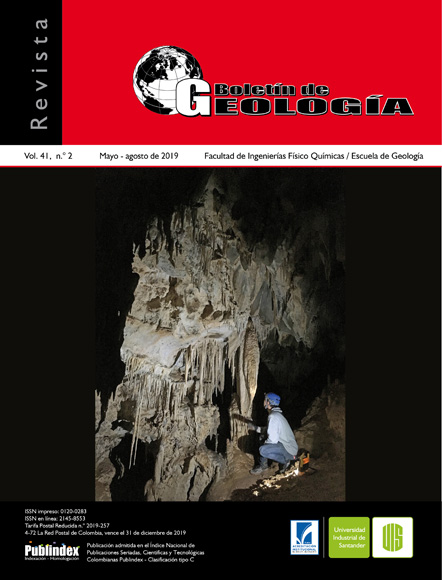Publicado 2019-05-29
Palabras clave
- Exploración geotérmica,
- sondeos superficiales de temperatura,
- sensores remotos,
- procesamiento digital de imágenes de satélite,
- geoestadística
- Pearson ...Más
Cómo citar
Altmetrics
Resumen
Se generaron modelos de temperatura a partir de Sondeos Superficiales de Temperatura (SST) y Sensores Remotos (SR), con imágenes Landsat 8 TIRS para el área geotérmica de Paipa. El rango de temperaturas a 20 cm de profundidad fluctúa entre los 17,04°C y 19,14°C. A 150 cm de profundidad, los valores de temperatura oscilan entre 16,81°C a 19.66°C. La normalización de los valores de temperatura en profundidad (20 cm y 150 cm) en función de la temperatura superficial, elimina el efecto de la radiación solar y permite comparar las temperaturas calculadas con SR tanto en superficie como en profundidad. El coeficiente de correlación de Pearson muestra que existen en su mayoría correlaciones negativas en profundidad (-0,1955) y algunas correlaciones positivas en superficie (0,3125) entre los mapas de anomalía de SST y SR. A su vez se incluyó un análisis de anomalías de uranio (38U) (0 ppm y 205,7 ppm), torio (32Th) (0,6 ppm y 94,2 ppm) y potasio (40K) (0% y 11,8%), mediante espectrometría de rayos gamma, topografía (entre 2500 msnm y 3200 msnm) y las anomalías de temperatura estimadas, encontrando altos y bajos con coincidencia espacial entre las variables.
Descargas
Referencias
Alfaro, C., Monsalve, M., Franco, J., y Ortiz, I. (2012). Modelo conceptual del sistema geotérmico de Paipa. Grupo de Exploración de Recurso Geotérmicos, Servicio Geológico Colombiano, Bogotá.
Baddi, M., Guillen, O., Lugo-Serrato, O., y Aguilar-Garnica, J. (2014). Correlación no-paramétrica y su aplicación en las investigaciones científicas. Daena: International Journal of Good Conscience, 9(2), 31-40.
Beardsmore, G. (2012). Towards a shallow heat flow probe for mapping thermal anomalies. 37th Workshop on Geothermal Reservoir Engineering. Stanford University, Stanford, California, EEUU.
Becerra-Gonzalez, L., Matiz-Leon, J.C., Ariza-Ariza, O., Borda-Beltran, D., y Medina, J. (2016). Aplicación de imágenes de satélite y de sistemas UAV para la producción de guayaba en la provincia de Vélez, Santander. UD y la Geomática, 11, 46-53.
Borgogno-Mondino, E., and Lessio, A. (2015). Estimation and mapping of NDVI uncertainty from Landsat 8 OLI datasets: An operational approach. IEEE International Geoscience and Remote Sensing Symposium. Milan, Italia.
Carslaw, H.S., and Jaeger, J.C. (1986). Conduction of heat in solids. 2nd edition. England: Oxford Science Publishers.
Coolbaugh, M., Sladek, C., Faulds, J., Zehner, R., and Opplieger, G. (2007). Use of rapid temperature measurements at a 2-meter depth to augment deeper temperature gradient drilling. 32nd Workshop on Geothermal Reservoir Engineering. Stanford University, Stanford, California, EEUU.
Coolbaugh, M., Sladek, C., Zehner, R., and Kratt, C. (2014). Shallow temperature surveys for geothermal exploration in the Great Basin, USA, and estimation of shallow aquifer heat loss. Geothermal Resources Council Transactions, 38, 115-122.
Eslava, J. (1992). Perfil altitudinal de la temperatura media del aire en Colombia. Earth Sciences Research Journal, 1, 37-52.
Farr, T., Rosen, P., Caro, E., Crippen, R., Duren, R., Hensley, S., Kobrick, M., Paller, M., Rodriguez, E., Roth, L., Seal, D., Shaffer, S., Shimada, J., Umland, J., Werner, M., Oskin, M., Burbank, D., and Alsdorf, D. (2007). The shuttle radar topography mission. Reviews of Geophysics, 45(2), 1-33. doi: 10.1029/2005RG000183.
Florides, G.A., and Kalogirou, S.A. (2005). Annual ground temperaure measurements at various depths. Proceedings of CLIMA. Lausanne, Switzerland.
González, L., Vásquez, L., Muñoz, R., Gomes, H., Parrado, G., y Vargas, S. (2008). Exploración de recursos energéticos. Exploración de uranio en Paipa, Iza, Pesca, Chivata (Boyacá). INGEOMINAS, Bogotá.
Kratt, C., Coolbaugh, M., Peppin, B., and Sladek, C. (2009). Identification of a new blind geothermal system with hyperspectral remote sensing and shallow temperature measurements at Columbus Salt Marsh, Esmeralda County, Nevada. Geothermal Resources Council Transactions, 33, 481-486.
Li, M., Liu, S., Zhou, H., Li, X., and Wang, P. (2005). The temperature research of urban residential area with remote sensing. Proceedings IEEE International Geoscience and Remote Sensing, 1514-1517.
Matiz-León, J.C. (2015). Modelo conceptual geológico – geofísico del área geotérmica de Paipa, Boyacá. Grupo de Exploración de Recursos Geotérmicos, Servicio Geológico Colombiano, Bogotá.
Mihalakakou, G., Santamouris, M., Lewis, J.O., and Asimakopoulos, D.N. (1997). On the application of the energy balance equation to predict ground temperature profiles. Solar Energy, 60(3-4), 181-190. doi: 10.1016/S0038-092X(97)00012-1.
Mwawongo, G. (2007). Geothermal mapping temperature measurements. Short Course II on Surface Exploration for Geothermal Resources, organized by UNU-GTP and KenGen. Lake Naivasha, Kenya.
Norini, G., Gropelli, G., Sulpizio, R., Carrasco-Núñez, G., Dávila-Harris, P., Pellicioli, C., Zucca, F., and De Franco, R. (2015). Structural analysis and thermal remote sensing of the Los Humeros Volcanic Complex: Implications for volcano structure and geothermal exploration. Journal of Volcanology and Geothermal Research, 301, 221-237. doi: 10.1016/j.jvolgeores.2015.05.014.
Olmsted, F., and Ingebritsen, S. (1986). Shallow subsurface temperature surveys in the basin and range province - II. Ground temperatures in the upsal hogback geothermal area, West-Central Nevada, U.S.A. Geothermics, 15(3), 267-275. doi: 10.1016/0375-6505(86)90104-5.
Restrepo, L., y González, J. (2007). De Pearson a Spearman. Revista Colombiana de Ciencias Pecuarias, 20(2), 183-192.
Rodriguez, G. (2013). Sondeos térmicos superficiales en el área geotérmica de Paipa, Boyacá. Grupo de Exploración de Recursos Geotérmicos, Servicio Geológico Colombiano, Bogotá.
USGS. (2016). Landsat (L8), Data Users Handbook. Sioux Falls, South Dakota: U.S. Geological Survey.
Velandia, F. (2003). Cartografía geológica y estructural sector sur del municipio de Paipa. Informe Técnico. INGEOMINAS, Bogotá.
Velandia, F., y Cepeda, H. (2004). Geología sector Sur del Municipio de Paipa - Boyacá. Grupo de Exploración de Recursos Geotérmicos, Servicio Geológico Colombiano, Bogotá.

